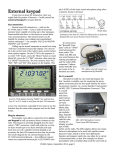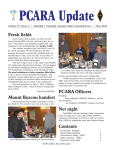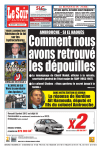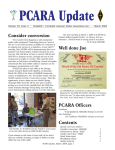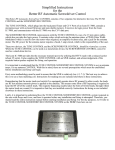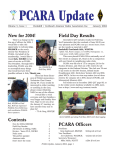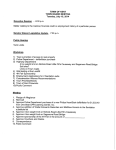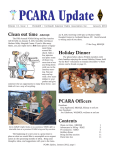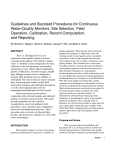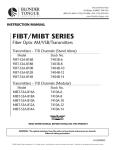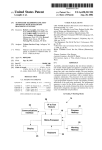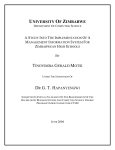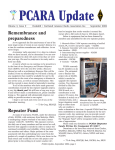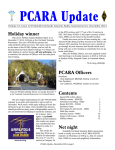Download See you in September PCARA Officers Contents Net night
Transcript
PCARA Update Volume 15, Issue 9 Peekskill / Cortlandt Amateur Radio Association Inc. September 2014 See you in September Among the highlights of the summer season from an amateur radio perspective, was the ARRL National Centennial Convention 2014 at the Connecticut Convention Center in Hartford, CT on July 17 - 19, 2014. The convention was well attended by a contingent from PCARA who carpooled to the convention and informed me that it was quite an excellent event! The activities included a visit to ARRL Headquarters in Newington, CT. The summer is coming to an end, but that doesn’t mean the fun has to stop. There are quite a few regional hamfests coming up in the next couple of months, so keep the following dates in mind: Ÿ Sunday Sept 14: Candlewood Amateur Radio Association Western CT Hamfest, Edmond Town Hall, 45 Main Street, Newtown, CT. Ÿ Saturday Sept 20: Garden State ARA Fall Hamfest, MOESC Building, 100 Tornillo Way, Tinton Falls, NJ. Ÿ Saturday Sept 27: Ocean Monmouth ARC Tailgate Hamfest, Infoage Learning Center, 2300 Marconi Rd, Wall Township, NJ. Ÿ Sunday Oct 5: Hall of Science ARC Hamfest, NY Hall of Science, 47-01 111th St., Flushing Meadows, Queens, NY. Ÿ Saturday Oct 11: BARA Fall Hamfest, Westwood Regional High School, 701 Ridgewood Rd, Township of Washington, NJ. Ÿ Sunday Oct 12: Mt. Beacon ARC Fall Hamfest, Employee Recreation Center, 83 Red Schoolhouse Rd, Fishkill, NY. Ÿ Sunday Oct 12: Meriden ARC Nutmeg Hamfest, Sheraton Four-Points Hotel, 275 Research Parkway, Meriden, CT. Now that we’re back from our summer break, we have to begin planning upcoming events for the months ahead. Bring any and all of your ideas and suggestions with you to the September 2014 meeting, on Sunday September 7, 2014 at 3:00 pm at Hudson Valley Hospital Center in Cortlandt Manor, NY. I look forward to seeing each of you there. - 73 de Greg, KB2CQE PCARA Officers President: Greg Appleyard, KB2CQE, kb2cqe at arrl.net Vice President: Joe Calabrese, WA2MCR; wa2mcr at arrl.net Contents See you in September - KB2CQE Adventures in DXing - N2KZ Summer medley External keypad - NM9J Coaxial care - NM9J 1 2 6 9 12 Net night Peekskill/Cortlandt Amateur Radio Association holds a weekly net on the 146.67 MHz W2NYW repeater on Thursdays at 8:00 p.m. Join net control Karl, N2KZ for news and neighborly information. PCARA members register at the entrance to ARRL’s Centennial Convention in Hartford, CT on July 19. PCARA Update, September 2014, page 1 Adventures in DXing - N2KZ Allons-y (let’s go) Consider it a modern miracle: You board a plane and, eight hours later, you are across the world. My flight took off from Newark at 1:00 AM and delivered me to Paris, France just before déjeuner (lunch time.) Upon arrival, Americans in Paris need to adapt to their new surroundings. It’s easy, if you know how! Things have changed since I last visited Paris 25 years ago. Now nearly everyone speaks English without hesitation and speaks it well. The atmosphere is warm and welcoming. The overall demeanor is casual and relaxed. All signs said ‘good times ahead.’ It felt nice to be there. First things first... When in France, you should drive a French car. We rented a Renault Mégane, a sporty five-door hatchback coupe. Driving was effortless. The French drive on the right side of the street, just like in America, and the roads are refreshingly smooth and well-kept. Even in the most rural areas, axle-bending potholes are missing in action and road debris is never to be seen. The highways run fast with posted speed limits up to 130 kilometers per hour (81 mph.) You’ll see lots of French and German vehicles: Renault, Citroën, Peugeot along with Mercedes-Benz and BMW. Volkswagens and Fiats are fairly common, too. Once in a blue moon, I would see a compact Ford but they were not easy to find. One peculiarity was learning the concept of the French ‘priority’ road regulations. Just because you are rolling along on what seems like a major road doesn’t mean you have the right-of-way! Mégane’s megahertz In any case, what is the first thing to do when starting up a new rental car? Of course, the answer must be ‘play with the radio!’ The front plate of the radio provided the ability to scan two bands: FM and longwave combined with medium wave. It seemed like the only way to create Touchscreen of rented Renault Mégane. presets was to first scan and capture a station. There was no direct tuning to be seen! I instantly found Paris’ only prominent medium wave station, France Bleu, on 864 kHz and the two megawatt France Inter outlet on 162 kHz longwave. Long wave memories Not until I headed north towards Normandy did I hear radio in English. I had never experienced longwave broadcasting before and it quickly became my link to world news and sports! I quickly adopted two new favorite stations: BBC Radio 4 on 198 kHz and RTE Radio One from Ireland on 252 kHz. Both can be heard day and night nearly all the way into metropolitan Paris and were loud The Normandy American and clear as I rode Cemetery at Omaha Beach. through the Normandy countryside for the next few days. I had no luck picking up BBC Radio Scotland on 810 kHz with any consistency day or night. See? If I had gone to Edinburgh instead, I wouldn’t have this problem! The penetration of longwave is hard to believe. Some stations simply would not die! Using my trusty Sony ICF SW7600GR portable, I even heard the BBC on 198 inside a hotel room at Charles de Gaulle Airport ensconced by concrete and steel! Another remarkable Normandy beaches. station was on 153 kHz, Deutschlandfunk from Donebach, Germany, blazing a cool 500 kW. I quickly added it to my ‘can hear it anywhere’ list. Sussex signals Discovering my first two English language longwave stations was only the beginning! On day two of my trip, I stumbled across true manual tuning on my car’s radio. I had to remind myself that it is now the year 2014. Tuning knobs don’t exist anymore. Radios are tuned via the touchscreen on your dashboard! I drilled down a few menus under the ‘Media’ folder and found my way to a touch and tune screen where I could create presets for any frequency I wished regardless of being able to pick it up. A major breakthrough! You’ll find lots to listen to in English, if you know where to find it! Driving into the town of Honfleur, just PCARA Update, September 2014, page 2 outside the major port of Le Havre, I started hearing all sorts of British stations beaming across The English Channel broadcasting from nearby Sussex. Dominant on medium wave was Smooth Radio on 945 MF and LF Transmitter sites in southern England (tower symbol) heard by Karl in kHz with a France, including Bexhill 945/693 kHz. pleasant oldies hits format. The first weekend we were there, Smooth was featuring an all-American Motown weekend. Perfect! BBC Radio 5 Live outlets on 693 and 909 kHz were also easy to receive. During the middle of the day, these two BBC outlets would go through long dramatic fades and phasing but never losing their signal strength — probably due to multiple transmitter sites operating in synchronicity. These were great big emissions of RF. No matter what mix of propagation came their way during the day the muscle of BBC’s signals held on tight and never let go. You’ll never witness this kind of dominance in the USA. Our limit is single transmitters at 50,000 watts. We don’t do megawatts. The Europeans certainly do! in-between could be logged. CW was quite alive and well especially on 20 and 40 meters. I even heard a 25 watt NAV-aid beacon, LHO from Le Havre, on 346 kHz longwave. If I haven’t yet convinced you to bring a general coverage receiver with you when visiting Europe, let me add this: Many, many North American radio station Internet streams are geo-blocked across the pond. Don’t expect to hear Newsradio 88 WCBS overseas. One exception is National Public Radio in the clear, imported from America via the web, but you also have to consider the time difference. Wake up in the morning to shave and shower in France and you’ll quickly notice it is about 1:00 AM in the morning on the east coast of the U.S! American morning drive time starts right around lunch time in Europe! English channel I later came to appreciate other U.K. music stations that could be heard at night like Absolute Radio on 1215 kHz and Capital Gold from London on 1548 kHz. Remember Europe follows a 9 kHz channel standard instead of the 10 kHz spacing familiar to North Americans, hence odd-looking (to us) operating spots like 198, 693 and 909 kHz. Check your portable radio’s manual before you leave home. Many receivers can be converted to a 9 kHz standard with just a couple of hidden button pushes. I am pleased to report that there is no lack of amateur radio operators in Western Europe. Using just a few feet of wire as an antenna, I heard many operators in SSB, CW and RTTY without any trouble. Italy, Great Britain, Sweden, Poland, Spain and everything Euro-power French household A/C power is different than what you are accustomed to in America. You won’t find plugs with flat blade connections here. A/C plugs French modulation (FM) French FM radio really reminded me of America. Of course, everything is spoken en français, but they have our act down and know it well. Jingles, sounders, hot talking DJs, commercial clutter… yes, it’s all here too, just like at home. [‘Sounder’ = short musical sequence to identify a station or network –Ed.] In Paris, there are dozens of FM stations to choose from. Very popular with mature adults is RTL, the descendant of the legendary Radio Luxembourg, with an interesting mix of thoughtful talk and eclectic music. Think of RTL as a peppy and energetic full-service station. French young adults prefer all hit stations like NRJ. Nouvelle Radio des Jeunes, (literally ‘New Youth Radio,’) always has enough N R J to reach the top of audience ratings. One station really made me smile: Music Box on 92.8 FM in Paris. Format? New American Country! Rest assured, there is plenty of Blake Shelton to hear in Paree. Amazing! French power outlet has ground connection pointing outward. PCARA Update, September 2014, page 3 feature two sturdy round pins going into the wallplate and one round pin coming out of the wallplate for ground (earth.) The two main pins are slightly different in size and not centered on the face of the round plug making it impossible to insert it upside down inverting neutral and hot. French A/C plugs make a very firm fit. Here the standard is 240 volts instead of North America’s 120 volts. If you are only interested in powering your computer or cell-phone, you may only need a simple passive plug adapter. Many high-tech power supplies can accept voltages from 100 to 240 volts without any problem. Read the fine print on your device carefully to decide. Active 240 to 120 voltage converters are easy to find and inexpensive, but don’t expect to power a hair dryer, coffee pot or other high current device with it. A/C current runs at 50 not 60 cycles per second in France. Your American clock will keep really odd time if you try it in Europe! Also, remember that Wi-Fi is pronounced ‘Wee-Fee’ when you ask for it in Paris. La télévision French television has improved vastly since the advent of digital. Back in the days of analog, the French used a very complex television standard called SECAM, Séquentiel Couleur à Mémoire, (literal translation: ‘sequential color with memory’) that depended on the local 50 Hertz alternation of A/C power. The result was a stunningly beautiful picture with perfect color fidelity and hue but the most annoying 50 Hertz picture flicker since viewers first saw primitive movies in theaters! New widescreen digital TVs have a much faster refresh rate than 50 cycles and now the flicker is gone. Most everyone receives TV via satellite. All channels ride on a multiplex called TNT (Télévision Numérique Terrestre) also available in most places over-the-air on UHF. In France, the UHF antenna design of choice is a long Yagi with a corner reflector. L’antenne French UHF TV antennas have a look that distinguishes them from all others. Sometimes you’ll see modified Yagi designs that feature three sticks coming out Yagi antennas for French UHF TV from the corner reflector (instead of one director stick like you’ll see in North America) to optimize reception on different narrow UHF bands. They also can tilt up and down from true horizontal. Tilting is quite popular in the neighborhoods near the Eiffel Tower where UHF Yagi antenna with three rows of the target trans- directors, tilted upward. mitters are literally up in the sky for viewers to catch. Look carefully up on top of buildings wherever you go and you’ll see a little bit of French TV history. Most all terrestrial broadcasts seem to now be on UHF in horizontal polarization. There are still some remnants of much older upper VHF antennas, still surviving on rooftops, in both polarities — vertical and horizontal. I’ll bet the oncoming of digital TV pushed the French above 300 MHz just like in North America. Some things really made me think. I saw two types of FM radio antennas on rooftops. One was a Vertical S-loop FM antenna hula-hoop like design similar to those used by FM transmitters in the USA. Want to really scratch your head in wonder? The French also use FM band S-loop antennas… but they mount them vertically. It makes a very unusual visual to this DXer’s eyes! The best quiz was sitting down to a French computer and trying to negotiate an ‘AZERTY’ format keyboard. Just try to find and type an ‘@’ sign — or — look for a dot for your dot-coms or dot-frs (for Detail of a French ‘AZERTY’ France!) It’s really keyboard. interesting! PCARA Update, September 2014, page 4 Keep your eyes open wherever you go! In a museum dedicated to the Normandy invasion, I found a Morse code key not hooked up to a transmitter but a naval signaling light. Cool! Networks The premiere network in France is TF1 watched by almost a third of all World War II signaling light viewers at any given with Morse key. moment. It is literally channel one on the TNT delivery system and is a high profile first-class network in every respect. Big events always seem to appear on TF1. World Cup soccer on TF1 looked positively stunning on the flat-screens I saw everywhere we went. Also available are a complete set of state-owned channels: France 2, France 3, France 4 and France 5 all with their own personalities. Canal+ (pronounced Canal Plus) is the French version of HBO and is the foremost subscription service in the country. You’ll know right away if someone is a subscriber. A Canal+ decoder box is a beautiCanal+ decoder box below Philips TV. fully stylized black contrasting with white box with a distinctive European look and is a regular companion to French flatscreens. Dozens and dozens of alternate channels fill up the rest of the French TV spectrum. There is never a shortage of TV programming to watch in France! Expect to see quite a variety of international television when you stay at high end hotels, especially in Paris. On your TV menu you’ll find the BBC, Germany’s WDR, NHK from Tokyo, CCTV from Beijing, TVE Spain, RAI Italy, and even stations from the Middle East and South and Central America serving a wide variety of tourist’s tastes. C’est la vie (green) French society should be applauded for their green approach to daily life. Many, many French automobiles rely on diesel fuel (sometimes called gaz-oil) for excep- tional mileage. In Paris, you’ll also see innovative all-electric Autolib’ Bluecars charging their batteries along many streets. Become a subscriber to Autolib’ and you can travel green from point to point, on demand, Pininfarina Bluecar recharging from an whenever you Autolib’ port in Paris. need a car. Automatic motion-sensing light switches are installed everywhere you can imagine to conserve every possible electron. Move around a little while you are in a public hallway or bathroom or you will find yourself in the dark! Even the toilets themselves have two plunger buttons on the top of the water holding tank for a light or full flush to conserve usage. One thing that caught my eye was a can of 3-In-One oil in a Paris hardware store labeled ‘3-En-Un.’ Rest assured, WD-40 is still called WD-40 in France! Nearly every store had a big ‘SOLDES’ sign in their front window declaring to everyone that an amazing sale was going on. French oil. Après tea You may want to snack during the afternoon. Restaurants don’t even begin to serve dinner before 19h 30 (7:30 pm). Save room for dessert! The pastries and breads are outstanding and creatively presented everywhere you go. Also, be prepared: The French still love to smoke cigarettes and you’ll smell tobacco all over town. When you are not listening to the radio or trying to DX terrestrial TV, you should spend some time visiting all the spectacles you’ll find in France. To me, leisurely visits to Paris’ art museums are comparable to making a pilgrimage to church. Enjoy the beauty you will find at The Louvre, The Musée d’Orsay, The Rodin Museum and the renovated Orangerie. It’s only the beginning! Cathédrale Notre Dame, Centre Georges Pompidou and the Opera House should all be on your must-see PCARA Update, September 2014, page 5 list. After dusk, The Eiffel Tower is lit with a warm orange glow. At night, at the top of every hour, there is a spectacular display featuring hundreds of little strobe lights covering the tower with star bursts. What a show! and what a view from the top! enjoyed the day. Outdoors the weather was pleasantly cool for July and there were plenty of vendor tables. Inside the main pavilion were a number of commercial vendors — along with a table containing much equipment for sale by Ray, W2CH. (Ray and Marylyn’s table has been a feature of several hamfests this year.) Au revoir Enjoy France and don’t Eiffel Tower by daylight. forget your general coverage radio! You have to experience the wide area coverage and all the new challenges of DXing long wave! On my next visit, I’ll need to arrange the aid of some devoted TV/FM DXers and radio amateurs to bring my reception to the next level. It is difficult to discretely disassemble hotel TV installations so you can experiment! France: Merci beaucoup pour la belle visite. Au revoir de N2KZ ‘La Vieille Chèvre.’ 73 et dit dit. Summer medley During the annual summer break months of July and August, there have been quite a few events involving PCARA members. July in Augusta On Sunday July 13, the Sussex County Amateur Radio Club Hamfest took place at the County Fairgrounds in Augusta, NJ. It isn’t the easiest place to find thanks to the distance from major highways — nevertheless several PCARA members made the journey and Henry KB2VJP checks out a cable on offer at the Sussex County ARC Hamfest on July 13. Indoor pavilion at Sussex County ARC Hamfest included a table where Marylyn KC2NKU and Ray W2CH were selling. Classy Centennial One week later on Saturday July 19, PCARA members joined in multiple carpools to visit the ARRL National Centennial Convention at the Connecticut Convention Center in Hartford. Saturday was the final day of an enjoyable three-day event with talks and presentations from many famous radio amateurs. Your editor enjoyed the talk by Riley Hollingsworth, K4ZDH “What we owe the amateur service” followed by a presentation on “Software Defined Radio for Beginners” by Stephen Hicks N5AC of Flex Radio Systems. One floor of the Convention Center was dedicated to an extensive exhibition by a large number of amateur radio manufacturers, vendors and organiza- Lovji, N2CKD checks the HF transceivers on show at ARRL’s Centennial Convention in Hartford, CT on July 19. PCARA Update, September 2014, page 6 tions. Just about every name you are familiar with from the advertising pages of QST had a presence, and many commercial vendors were doing good business. PCARA members were busy checking out all the latest equipment from Kenwood, Yaesu and Joe WA2MCR inspects high power amplifiers at the Ameritron booth in Icom, which was on display ARRL’s Centennial exhibition area. with antennas connected, ready for a test-drive. In the area dedicated to overseas radio clubs, I paid a visit to the Radio Society of Great Britain’s booth, where I met RSGB President G3WKL. Incidentally, RSGB celeRSGB-ARRL pin. brated its own Centenary in 2013. NM9J/G3VNQ visits the RSGB booth at ARRL’s Centennial Exhibition, manned by RSGB President Dr John Gould G3WKL and Mark M1MPA. Highway to Headquarters Your editor and Joe WA2MCR joined one of the bus tours to ARRL Headquarters in Newington, which is only five miles from Hartford. We signed in then had a good look around the Headquarters Building — I even had a chance to chat with the Editor of QST, Steve Ford WB8IMY. Editing a 170 page national journal is a much larger undertaking than our little newsletter! Sitting in the editor’s chair at ARRL HQ was Steve Ford WB8IMY, editor of QST. Joe and I also paid a visit to W1AW, the Hiram P. Maxim Memorial Station, in the grounds of ARRL Headquarters, where ARRL news bulletins and code practice transmissions are produced. The ‘studios’ were all busy with licensed visitors operating under the W100AW commemorative callsign. W1AW has an impressive array of equipHiram Percy Maxim Memorial Station ment, feeding W1AW at ARRL HQ [photo by W2CH]. antennas you can only dream about. Back at the Convention Center in Hartford, after the impressive closing ceremony, I was left wishing that we could hold Centennial Conventions more often than once every hundred years! Congratulations to all concerned on a fine event. Newington revisited Most people agreed that the short tour of ARRL Headquarters and W1AW did not give enough time to PCARA Update, September 2014, page 7 take everything in — so on August 9, Ray W2CH and Marylyn paid another visit to Newington. They thought they would tour ARRL HQ before lunch with volunteer guide Skip, W1FTE, but then one of the studios — with an Icom IC-7700 for 20 meters — opened up, so they went back to the W1AW building to operate as W100AW for an hour. Ray and Marylyn outside the W1AW building [W2CH pic.] They had some contacts in the Extra and General portions of the 20 meter band, with stations happy to work them using the special Centennial call of W100AW. So before lunch Ray and Marylyn had already qualified for their official certificate, signed by station manager Joe Carcia NJ1Q to say they had operated W100AW as part of the ARRL 100 Year celebrations. After lunch they returned to W1AW, operating On the way home, our intrepid pair paid a visit to Lentini Communications in Berlin, CT. This is an amateur radio store and a music store. During the trip, Ray was trying out his Ray’s Leixen VV-898 compact 144/440 MHz latest acquisition mobile transceiver runs 4/10W output. from the far east, a Leixen VV-898 dual band mobile transceiver. Footnote: If you decide to pay your own visit to W1AW, be sure to check the opening hours and take your amateur radio license along with you in order to operate at the station. High in Haledon A few weeks later on Saturday August 23, it was time for the Ramapo Mountain ARC Hamfest, which is now in its fourth year at Camp Veritans, Haledon, NJ. This is an excellent location, with an indoor building for the commercial vendors — including KJI Electronics — plus leafy glades providing welcome shade for the outdoor flea market tables. Ray and Marylyn had an outdoor space, selling radio equipment at this Bob N2CBH and Mike N2EAB check out year’s Haledon W2LCN’s 13 cm mesh network at the event. The Ramapo Mtn ARC Hamfest on August 23. location is a little difficult to find, so be sure to bring your GPS and a good map. W100AW Operating certificate. - NM9J 20 meters, with the beam on Europe, where they worked a number of stations from the UK and Ireland, around to OE4BHA in Austria (in German) and UA1AML in Saint Petersburg, Russia. PCARA Update, September 2014, page 8 External keypad pin 6 (GND) of the 8-pin round microphone plug when a memory button is pressed. If you have an Icom HF transceiver, then you might find this project of interest — build yourself an external keypad for around $34.00. Key memories Recent Icom HF transceivers — such as the IC-7410A and IC-7000 — have a built-in electronic memory keyer capable of storing up to four messages. Some models also have a voice keyer to record short voice announcements. The memory keyer can be helpful for sending your callsign and standardized contest exchanges — for example “CQ CQ de W2NYW W2NYW” and “2A ENY”. Calling up the stored memories is carried out using “soft keys” positioned around the display. You need to be in the correct part of the radio’s menu system before these options appear. On the IC-7410, the sequence is to select “CW” mode, press the “Menu” button to reach Menu M1, press the F-4 “KEY” selection, then press the F-2 “SEND” function-key. The four memory keys “M1”, “M2”, “M3” and “M4” then appear on the display. This Icom IC-7410 display showing “MENU” key and function keys F-1 to F-5, ready to send from the four CW memories. is not very convenient, especially if you want to use the function keys for some other purpose such as the Band Scope. Plug-in shortcut Fortunately, Icom allows connection of an external keypad to call up memory keyer contents at any time. This keypad is normally plugged into the transceiver’s “MIC” connector, which will either be a screwon 8-pin round type or an 8-pin modular jack type. Icom does not sell a suitable external keypad as an accessory for their HF transceivers but they do provide the circuit diagram for an external keypad in the IC-7410 Instruction Manual — four different resistor values are connected between pin 3 (UP/DOWN) and Schematic from Icom IC-7410 User Manual for an External Keypad that can access the four stored memories. In recent years, the “BetterRF Company” sold an “i-Mate” external keypad for Icom radios. The i-Mate cost $85 and was wired between the existing microphone and the radio’s MIC connector. Unfortunately BetterRF does not seems to be in business any more. The i-Mate external keypad was manufactured by BetterRF. Do it yourself I decided to build my own external keypad, but first I needed a suitable case for mounting the microphone connectors plus the four push-buttons for selecting memory contents. At a recent hamfest I had spotted an MFJ-1251 “Universal Microphone Converter”. This is a small metal box with front panel connectors for both an 8-pin round microphone plug and for an 8pin modular plug. Separate cables are provided for conMFJ-1251 Microphone Control necting the Center from MFJ Enterprises. adapter to either type of MIC socket on the radio. The MFJ adapter allows one manufacturer’s microphone to be used with another manufacturer’s radio, which is often wired differently. Headers and jumpers inside the case allow for a variety of interconnections, so that (for example) an Alinco microphone with a modular plug could be used with an PCARA Update, September 2014, page 9 Icom radio having an 8-pin round MIC socket. I thought the MFJ-1251 would provide a good basis for my external keypad. At the ARRL Centennial Convention in Hartford I purchased an MFJ-1251 adapter from MFJ’s own booth. The price was $29.95. Next day I purchased a packet of four momentary pushbutton switches from Radio Shack — part number 275-1547, price $3.99. These are the ‘normally open’ type. Total so far — $33.94. Radio Shack momentary pushbutton switches. The right connections The first task was to evaluate the circuitry of MFJ’s Universal Microphone Adapter. MFJ provides an Instruction Manual containing the schematic plus connection diagrams for various combinations of microphone plug and radio manufacturer. My plan was to use the Icom radio’s original HM-36 microphone with the matching 8-pin round MIC socket on the Icom transceiver. Unfortunately that straight-through combination is not included in the manual. (Not unexpected though!) Careful examination of the schematic showed that MFJ selects four wires coming in from the microphone for MIC-GND, MIC-AUDIO, MIC-PTT plus the 8 volt DC feed to power any microphone circuitry, labeled THRU/PASS. These four lines are then connected through appropriate jumpers to the correct pin-numbers on the radio’s “MIC” connector for: RADIO-MICGND, RADIOMIC-AUDIO, RADIO-PTT and the THRU/PASS +8V DC line. The black ovals in the diagram alongside MFJ-1251 jumper settings for an Alinco modular-plug microphone connected to an show the Icom radio with an 8-pin round MIC input. (default) jumper settings for an Alinco modular microphone plug connected to an Icom 8-pin round MIC connector. In order to arrange a “straight through” microphone connection for Icom-to-Icom, all you have to do is combine the left-hand side of the diagram for your microphone connector with the right hand side of the diagram for your radio’s MIC connector. See the accompanying picture Modified jumper settings for an Icom 8-pin for an round microphone connected to an Icom radio with 8-pin round MIC input. example for “Icom 8-pin Round Microphone Connector” combined with the diagram for an “Icom 8 pin Round Radio”. (For readers who might have an Icom radio with an 8-pin modular jack, I have provided a smaller diagram for “Icom Modular Microphone ConJumper settings for an Icom nector” to an “Icom Modular Radio”. I have not modular microphone plug connected to an Icom radio been able to test this with modular MIC input. arrangement myself.) Step-by-step In order to setup an MFJ-1251 adapter for a straight through connection, first move the jumpers from their default settings onto new headers as shown in the appropriate diagram — see the photo alongside for an example. You MFJ-1251 with modified jumper settings for an Icom 8-pin round microphone plug should then carry out a to an Icom 8-pin round MIC connector. continuity check with a multimeter on its ohms position to confirm the connections from the 8-pin round micro- PCARA Update, September 2014, page 10 phone connector on the front panel to the 8-pin round microphone plug on the supplied cable. The important pins to check are: 1. Microphone input 2. +8V DC output 5. PTT 6. GND (PTT ground) 7. GND (Microphone ground) Next, you will need to drill four holes for the momentary switches in the lid of the MFJ-1251 case. For the Radio Shack switches, holes should be 17⁄64" diameter and spaced 5⁄8" apart. Position the line of holes equidistant from the front panel and rear panel to avoid other components inside the metal case. Mount the four Radio Shack switches in the holes, then solder connecting wires and four resistors to the switches as shown in Icom’s circuit for an external keypad. The resistors I used — 1.5 kΩ (two off), 2.2 kΩ and 4.7 kΩ, 1/8 watt — came out of my junk box. up photo and accompanying diagram. The Icom HM-36 microphone has two buttons on top labeled “UP” and “DOWN” for changing frequency and memory channel. I wanted these Pinout and wiring of the buttons to continue operaunused modular jack tion when connected position “J2” on the through the MFJ-1251 adapter. MFJ-1251 PCB The UP and DOWN buttons (component side). work in a similar way to the memory keyer buttons — the DOWN button connects MIC pin 3 through a 470Ω resistor to ground (pin 6) while the UP button directly grounds MIC pin 3. Icom 8-pin round microphone connections as seen from the front panel. (From the IC-7410 Instruction Manual.) The four momentary push-button switches and four resistors are mounted in the lid of the MFJ-1251 metal case. The components mounted in the top cover have to be wired to Pin 3 and to Pin 6 of the 8-pin round microphone connector output. The easiest way to do this is to employ the empty position “J2” which is provided by MFJ on the circuit board for an additional modular jack socket, but which is not used in this particular product. J2 is located just beneath the front panel 8-pin round connector. Access for soldering to J2 is available if you gently Close-up shows two wires from the case- push the round conneclid switches soldered to the empty RJ45 modular jack position “J2”, at the pin 3 tor wires out of the way — and pin 6 locations. (Pin 1 is closest to camera.) see the close- All you need to do to arrange for continued UP/DOWN operation is to connect pin 3 of the 8-pin round MIC connector on the MFJ-1251 front panel to pin 3 of the empty modular jack position “J2”. A short length of wire can be soldered between the appropriate pins. J2 pin 3 should already have one of the wires from the four push-buttons connected to it via 1.5 kΩ. Final check Before you plug the modified MFJ-1251 into your expensive Icom radio, take a moment to verify all the connections using an ohmmeter. There is a chance of damaging the radio if the +8V supply has been wired incorrectly. Pins 1, 2, 3, 5, 6 and 7 on the front panel’s round connector should be connected straight through to the same positions on the 8-pin round plug. Pins 6 and 7 (GND) will be connected to each other. In addition, you should check the resistance between pin 3 and pin 6 when each of these buttons is pressed — the ohmmeter reading should be as follows: M1 button M2 button M3 button M4 button Freq DOWN Freq UP PCARA Update, September 2014, page 11 1.5 kΩ 3.0 kΩ 5.2 kΩ 9.9 kΩ 470 Ω 0Ω If all is well, plug your microphone into the modified MFJ adapter, then plug the adapter cable into your Icom transceiver’s MIC socket. Before you check operation, you will need to enable “External Keypad” capability using the radio’s “Set Mode” menu. For the IC-7410, hold down the “Menu” button to enter Set Mode, then choose menu item 37, “External Keypad” and change from External keypad with the four memory the default buttons M1 - M4 suitably labeled. “OFF” to “KEYER SEND” by rotating the VFO dial control. For enabling of other Icom models, check your radio’s Instruction Manual. Make sure that the four keyer memory buttons are working correctly, along with the normal functions of the microphone — PTT, UP, DOWN and microphone audio. If you are using a headset which requires receiver audio from the radio, you will also need to manually wire pin 8 (center pin on the round microphone connector) through to pin 8 on the output connector in a similar manner to the wiring for the UP/DOWN buttons. Ready for some CW! The external keypad based on an MFJ-1251 is shown in-line with the Icom HM-36 hand microphone and cabled to the Icom IC-7410 8-pin round MIC input at bottom left. Choose your Icom Bear in mind that different Icom HF transceivers may need some modification to these instructions, especially if the radio has a modular MIC jack. Check the radio’s Instruction Manual for connections to the microphone, for suggested circuitry of an external keypad and for the “Set Mode” menu item that will enable the external keypad. Icom models with a memory keyer include the IC-746 Pro, IC-756 Pro 2 and 3, IC-7000, IC-7100, IC-7410, IC-7600, IC-7700 and IC-7800. The high-end IC-7700 and IC-7800 have a separate 3.5mm stereo input jack for their external keypad. Best of luck with this little project! My own external keypad has already been put to good use for some DX CW contacts. - NM9J Coaxial care After this year’s Field Day, I had several coaxial cables that needed attention. This prompted some thoughts on the general care of coaxial feeders for the radio amateur. Parts of a single-shield coaxial cable. PL problem The first item needing attention after Field Day was a 100 ft length of RG-213/U cable that had caused grief for the 6 meter station. A quick check with my Fluke digital multimeter revealed that the outer conductor was disconnected at the antenna end. Since the cable was full-size 0.405" outer diameter, I did not attempt recovery of the connector. I simply hacksawedoff the cable with the old connector and prepared the end for soldering on a new PL-259. Need to solder Detailed instructions for soldering standard PL-259 “UHF-series” connectors with and without adapters are available in several places including the ARRL Handbook, the Antenna Book and from the Amphenol web site: http://www.amphenolrf. com. Don’t forget to thread the coupling ring onto the cable before you start work on the connector body! PCARA Update, September 2014, page 12 PL-259 connector assembly. In my opinion, the most important factor for successful installation of a PL-259 connector is a soldering iron with sufficient power and thermal mass to bring the connector body up to temperature quickly. This will create a good soldered joint through the four holes in the connector body through to the pre-tinned outer conductor. A Weller solder gun is not sufficient for this task — you need a large iron that takes a while to warm up in order to solder the outer braid. A smaller Esico 6150 150 watt soldering iron iron can be used has large thermal mass in the tip. for the center conductor. Try to avoid outdoor breezes which will remove heat from the soldering iron and connector. Do not apply too much heat to the outer conductor or you will melt the polyethylene dielectric insulation that separates the inner and outer conductors. Melted insulation could allow conductors to move, introducing an impedance bump or — worse — you might short the inner and outer conductors together. One suggestion for preventing damage is to cool the connector body immediately after soldering by wrapping with a damp cloth. Another recommendation for successful soldered connections is to PL-259 connectors with just enough only use best- solder in the four solder holes to make a quality silver- good bond between connector body and plated brass braid. Center conductor is soldered inside PL-259 plugs. the center pin. They are easier to solder than the cheaper nickel-plated variety and maintain a more reliable connection. Good quality connectors are worth their weight in silver. Prehistoric procedure In my humble opinion, our continued use of solder-on “UHF-series” connectors in amateur radio is a throwback to World War II technology. The “UHF” coaxial connector was invented by Amphenol engineer E. Clark Quackenbush in the 1930’s, when UHF meant anything below 5 meters. In RF terms, the PL-259/SO-239 design is little better than a 4mm banana plug and socket with some shielding wrapped around it. The resulting impedance bump makes it unsuitable for use on modern UHF fre- quencies above 300 MHz. The procedure for soldering the outer conduc“Little better than a banana plug and tor of a PL-259 socket with shielding wrapped around.” is fraught with problems as you cannot see what is happening inside the connector body, and you cannot easily disassemble a soldered connector to check the innards. Production of a successful soldered joint in the typical amateur radio shack requires a lot of experience, the correct equipment and a certain amount of luck. If you still insist on soldering your PL-259s, there are some excellent hints from Alan K0BG at the following web page: http://www.k0bg.com/coax.html. Crimping your style An alternative to the traditional solder-on PL-259 is the use of crimp-on connectors. You will need to exactly match the connector size with the diameter of the coaxial cable as there are no small-diameter adapters for crimp connectors. You will also need a powerful crimping tool with the correct size die for the connector. Good quality crimping tools are relatively expensive — $50.00 to $150.00 — and crimped connectors cannot be re-used. Depending on how many PL-259 connections you need to make in a year, it might be more economical to purchase ready-made cables with the connectors already installed. Cold compress Another alternative to soldering PL-259 connectors is the type of fitting with a pressure sleeve, similar to N-type and BNC coaxial connectors where the outer braid is pushed over a metal clamp or ferrule, then kept in place by a compressed rubber gasket. In the USA, these are known as “clamp” connectors while in Europe they are called compression fittings. During my time in England, I purchased compression-style UHF connectors made by UK companies “Greenpar Connectors Ltd” and “Coline Connectors Greenpar sleeve connector has a top-hatLtd”. They were shaped sleeve that slides under the braid. easy to install and I still have a few in use today. The key design feature is the top-hat-shaped brass ferrule or sleeve which is pushed under the outer braid and jacket of the cable. When the clamp-nut is PCARA Update, September 2014, page 13 tightened, it compresses the silicone rubber gasket against the cable and pushes the ferrule’s flange tight against the connector body. This produces an excellent connection of great strength without having to solder the outer braid. Coline is no longer in business, while Greenpar has been absorbed by Tyco Electronics. Tyco / Greenpar connectors can be obtained from distributors such as Mouser and Digikey. Similar Multicomp ‘clamp’ connectors are available from Newark Electronics and from “The RF Multicomp “UHF Straight Connection” in Gaithersburg, plug clamp” MC17-01F-5 MD, http://www.therfc.com. Here are some part numbers: Tyco/Greenpar RG-58 male 1-1337473-0 RG-213 male 1-1478234-0* RG-58 female 1-1337652-0 Multicomp MC17-01F-5 MC17-01B-5 17-26F RF Connection RFC17-01F-5 RFC17-O1C SO-239/RG-58 *obsolete Casual coax Coaxial cable used for portable operation and special events needs special care. Stored cable should be rolled up and kept in a dry environment between activities. There are two recommended methods — in the over/under technique, alternating loops of Coaxial cable coiled up using the cable are coiled in opposite direc- “Over/Under” technique. tions. There are instructions on the following web site: http://techno-fandom.org/~hobbit/flipcoil/howto.html. Straight coiling. The alternative technique — which I prefer — is straight coiling, where the loops of cable are all coiled in the same direction, just as though a hosepipe was being wound onto an imaginary spool or drum. Straight coiling is easy to learn and fast to implement — important factors during any Field Day teardown. You should never wrap cable around your elbow like a rope or a skein of wool — or try to wind it into too small a loop. Once the cable is suitably coiled up, use Velcro cable ties to keep the coil together until it is needed again. Be proud of your coiled-up cables! Don’t store your coaxial cables in a tangled mess. Roll up neatly and use Velcro cable ties to keep the turns together. Tie me up One advantage of Velcro-brand hook-and-loop cable ties is the oblong hole at the wider end of the strap. By inserting the rounded end through the hole, the tie can be permanently attached to the cable so it cannot be lost. Velcro cable tie. Tangled web? Out in the field, the cable should be unrolled in the same way it was coiled. With the over/under technique, loops of wire can be pulled off or thrown out straight from the coil. But you must take great care not to pull cable off the wrong side of the coil or it will become thoroughly knotted. With the straight coiling method, cable should be unrolled in a straight line, just as though it was still wrapped around a large cable drum. Do not pull coils off the top of the reel, or you will end up with a seriously twisted cable. The reason for all this care with coiling and unwinding cable is to avoid twists, kinks and other strains that might compress the dielectric insulation, open the braid or shift Coax with a kink. and break the conductors. Compressing the dielectric will introduce an impedance bump and might cause shorting between inner and outer conductors. You should also take care not to damage the outer jacket, as this could allow water to enter — there is a later section describing the reasons for keeping your cable dry. PCARA Update, September 2014, page 14 It’s a stretch If you are installing coaxial cable permanently on a mast or tower, additional precautions are needed to ensure long-term reliability. Coaxial cable cannot support its own weight — this is especially true of the larger diameter cables. If you suspend a long vertical run of cable, there is a danger of the outer sheath, braid, polyethylene dielectric and inner conductor all moving relative to each other. The result could be breakage of a conductor or pulling the center-pin out of a connector. Because of this weight problem, it is inadvisable to pull the end of a long cable straight up a high mast or to lower a long length of cable from the top of a tower. Instead, the whole coil of coaxial cable should be taken up the mast, the end of the cable secured, then the remaining feeder should be unrolled down the mast, and fastened at frequent intervals. Use black cable ties that are rated for outdoor exposure and do not overtighten, or you might distort the cable. Be careful when bending the cable around a corner — the minimum bend radius for RG-8 and RG-213 is approx. 3" to 4", while for RG-58 it is 2". If the cable feeds a rotary antenna, leave a large loop around the rotator to avoid strain and excessive bending. Stranded cable is best for the rotator loop. All threaded connectors used outdoors should have the coupling ring tightened with pliers — handtightening is not sufficient to ensure a reliable connection through multiple temperature cycles. Dangerous when wet Whatever style of coaxial connector you choose, no design is 100% waterproof. When connectors are used outdoors, there are two dangers — first, water might enter the area between plug and socket, corroding the electrical contacts. Second, water could be drawn into the cable’s stranded wire through wicking action, corroding both inner and outer conductors. If the dielectric insulator is porous — for example the foamed polyethylene inside RG-8X — then water can be absorbed, changing the dielectric constant and increasing losses. Coaxial cable with corroded conductors or with water dripping out of the end is a total loss and must be replaced. The last thing you want to see on the copper braid is a coating of green verdigris! Bear in mind that a high-loss coaxial cable can show a perfect 1:1 VSWR at the transmitter end, even when there is a badly mismatched antenna at the far end. Run the tape Coaxial connectors used outdoors should be protected with a plastic boot and/or by wrapping the joint with plastic tape. A suggested treatment for permanent installation is to use a self-amalgamating tape such as Scotch 2228 rubber mastic tape Coaxial connectors exposed to the wrapped weather should first be wrapped with around the cona self-amalgamating tape such as nectors with overScotch 2228. lapping layers, followed by a top layer of Scotch Super 88 electrical tape for protection against wear and abrasion. These products are available from Home Depot. Aim to cover all gaps where water might enter the connectors, wind the tape so that any future gaps point downward and leave a “drip loop” at the end of the cable run so that rainwater is shed before it can get near a connector. If you need to Self-amalgamating tape should bury coaxial cable underground, there are be covered with a layer of vinyl tape for mechanical protection. additional requirements to keep the cable dry on the inside. Check the ARRL Antenna Book for details. Long term investment With the current cost of quality coaxial cable and connectors, you will want your investment to last a very long time. Take good care of your coax and it will be bringing you DX signals for many years to come. - NM9J PCARA Update, September 2014, page 15 Peekskill / Cortlandt Amateur Radio Association PCARA Calendar Sun Sept 7: PCARA meeting, Hudson Valley Hospital Center, 3:00 p.m. Mail: PCARA, PO Box 146, Crompond, NY 10517 E-Mail: mail ‘at’ pcara.org Web site: http://www.pcara.org PCARA Update Editor: Malcolm Pritchard, NM9J E-mail: NM9J ‘at’ arrl.net Newsletter contributions are always very welcome! Archive: http://home.computer.net/~pcara/newslett.htm Hamfests PCARA Information PCARA is a Non-Profit Community Service Organization. PCARA meetings take place the first Sunday of each month* at 3:00 p.m. in Dining Room B of the Hudson Valley Hospital Center, Route 202, Cortlandt Manor, NY 10567. Drive round behind the main hospital building and enter from the rear (look for the oxygen tanks). Talk-in is available on the 146.67 repeater. *Apart from holidays and July/August break. PCARA Repeaters W2NYW: 146.67 MHz -0.6, PL 156.7Hz KB2CQE: 449.925MHz -5.0, PL 179.9Hz N2CBH: 448.725MHz -5.0, PL 107.2Hz Sun Sept 14: Candlewood ARA Western CT Hamfest, Edmond Town Hall, 45 Main Street, Newtown, CT. 8:00 am. Sat Sept 20: Garden State ARA Fall Hamfest, MOESC Building, 100 Tornillo Way, Tinton Falls, NJ. Sat Sept 27: Ocean Monmouth ARC Tailgate Hamfest, Infoage Learning Cntr, 2300 Marconi Rd, Wall Twnshp, NJ. Sun Oct 5: Hall of Science ARC Hamfest, NY Hall of Science, 47-01 111th St., Flushing Meadows, Queens NY. Sat Oct 11: BARA Fall Hamfest, Westwood Regional HS, 701 Ridgewood Rd, Twnshp of Washington, NJ. 8:00 a.m. Sun Oct 12: Mt Beacon ARC Fall Hamfest, Employee Recreation Center, 83 Red Schoolhouse Rd, Fishkill, NY 8:00 a.m. Sun Oct 12: Meriden ARC Nutmeg Hamfest, Sheraton Four Points Hotel, 275 Research Pkwy, Meriden CT. 8:00 a.m. VE Test Sessions Sep 7: Yonkers PAL Ham Radio Club, 127 N Broadway, Yonkers. 2:00 p.m. Michael Rapp (914) 907-6482. Sep 7: Yonkers ARC, 1st Police Precinct, E. Grassy Sprain Rd, Yonkers, NY. 8:30 am. John Costa, (914) 969-6548. Sep 11: WECA, Westchester Co Fire Trg Cen, 4 Dana Rd., Valhalla, NY. 7:00 pm. S. Rothman, 914 831-3258. Sep 15: Columbia Univ VE Team ARC, 531 Studebaker Bldg, 622 W 132nd St, New York. 6:30 pm. Alan Crosswell, 212 854-3754. Sep 27: P.E.A.R.L., Mahopac Public Library, Periodicals Room, 668 Rt 6, Mahopac, NY. 10:00 a.m. Contact W2AG. Peekskill / Cortlandt Amateur Radio Association Inc. PO Box 146 Crompond, NY 10517 PCARA Update, September 2014, page 16
















